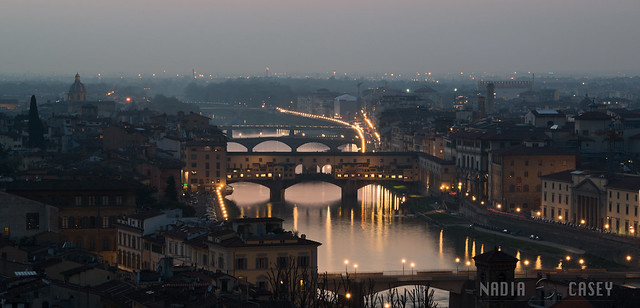
We are captivated by what Luigi Barzini in his book, "The Italians", calls the fatal charm of Italy. Barzini writes that the allure of Italy is that people are attracted to a certain quality in Italian life, whether they know what it is or not. He explains that we visit some places and try to re-create in our minds a life of long ago, of royal splendor, furnished palaces, knights, liveries, servants, and good cooks. We see shadows of distant characters out of novels and crusades. "Sunny Italy" is written into songs and poetry and to the average tourist the Italians seem happy, therefore we are drawn to the illusion that Italy is always sunny and happy and we want to go and relax in la dolce vita, (the good life).
"The pleasure of Italy comes from living in a world made by man, for man, on man's measurements."
(Luigi Barzini)
- Sunset Cityscape - Florence, Italy -
There are many regions in Italy, each with their own unique attractions and flavors, but the trips we want to cover in our next few posts are about Tuscany. On our first trip to Tuscany we visited Genoa and then took a train to Cinque Terre for a couple of days, and on to Pisa in the Morning and ended that day in Florence. We then traveled by car to San Gimignano and Volterra, Siena and on to Rome. On the second trip we started in Florence for a day, then spent the next day photographing Siena. The following couple of days we traveled through Monteriggioni and Colle di Val d'Elsa, Volterra. and San Gimignano, and then back to Florence.
We are going to start our photographic visit in Florence because it is the capital city of Tuscany and is often the entry point for many who will visit the region.
We are going to start our photographic visit in Florence because it is the capital city of Tuscany and is often the entry point for many who will visit the region.
~ Florence ~
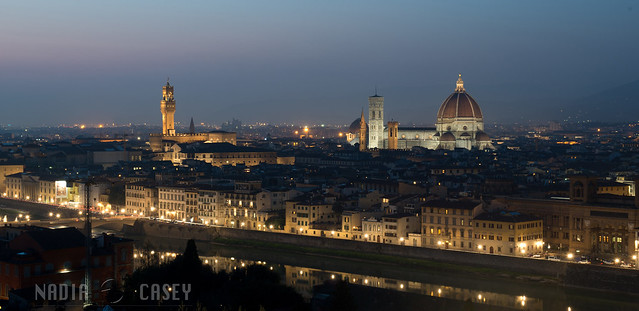
Florence Skyline
Florence is ranked by Forbes as one of the most beautiful cities in the world. We think it is the ultimate attraction for city-lovers whose interests lay in urban-life-culture with a renaissance feel.
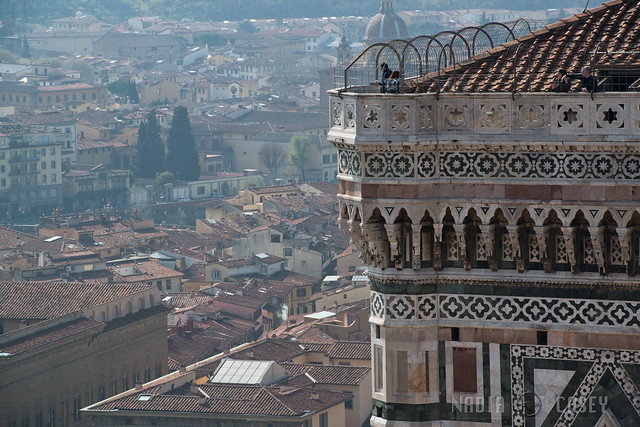
Viewing Florence from the top of Brunelleschi's Dome.
Florence was politically, economically, and culturally one of the most important cities in the world during the 14th to 16th centuries. It originated as a Roman city, then later flourished as a medieval city of European trade and finance, and was one of the wealthiest cities of the time. It is still noted for its culture, art, architecture, monuments, art galleries and some of the best museums in the world.
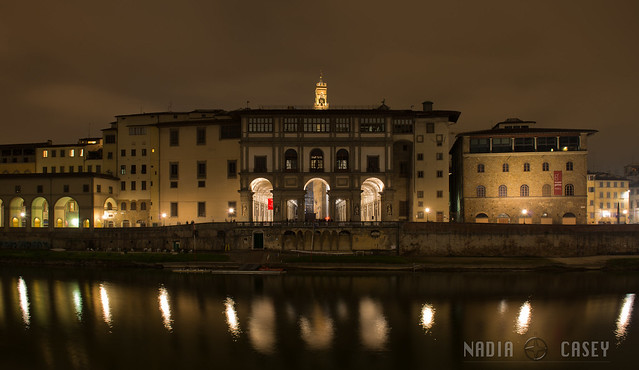
Uffizi Gallery
One of the greatest art galleries in the world is The Uffizi gallery. The original reason for its construction is interesting. Granduca Francisco de' Medici was in constant fear of attempts on his life, so in 1581, he had enclosed walkways and buildings built so he wouldn't have to walk outside amongst those who could take aim at him.
"The original design was that of Giorgio Vasari, one of the leading painters and architects during the 15th century. His plan for this museum was quite a strategically planned building as it was constructed adjacent to the Medici Palace and extended until the Arno river, over the Ponte Vecchio bridge. The space was originally intended for offices and to host bureaucratic meetings for various magistrates."
http://www.uffizi.com/
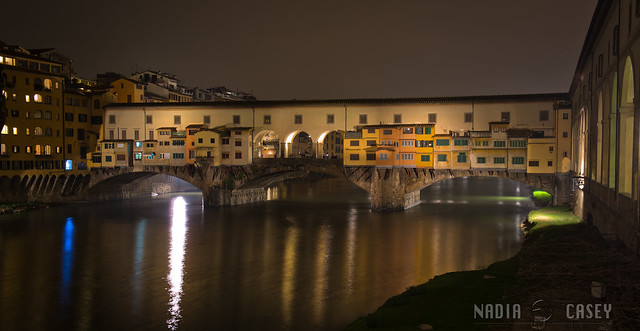
Ponte Vecchio (Old Bridge)
A medieval stone bridge over the Arno River, in Florence, Italy, noted for shops built along it, as was once common. Butchers initially occupied the shops; the present tenants are jewelers, art dealers and souvenir sellers.
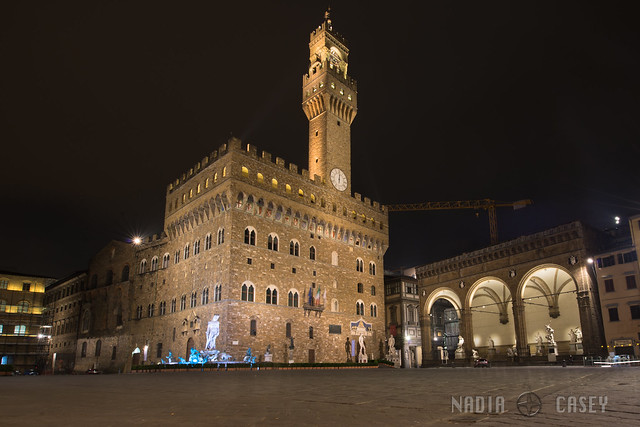
Palazzo Vecchio
The fourteenth and fifteenth centuries in Italy are frequently called, "the Golden Age", one of the most brilliant periods in world art history, and at its heart is Florence with its writers, painters, architects, and philosophers. It is considered the birthplace of the Renaissance. There are many famous men we think of when we think of the Renaissance, like DaVinci, Michelangelo, and Botticelli, however it was the The House of Medici, a rich, powerful, and influential banking family with a passion for culture, that gave us the Renaissance. The late 14th century was a time of rebirth in the appreciation of the classical past "that changed the face of western culture and left no doubt that the Medici were the patrons, the catalyst of genius."
PBS.org Medici/Renaissance
education-portal.com
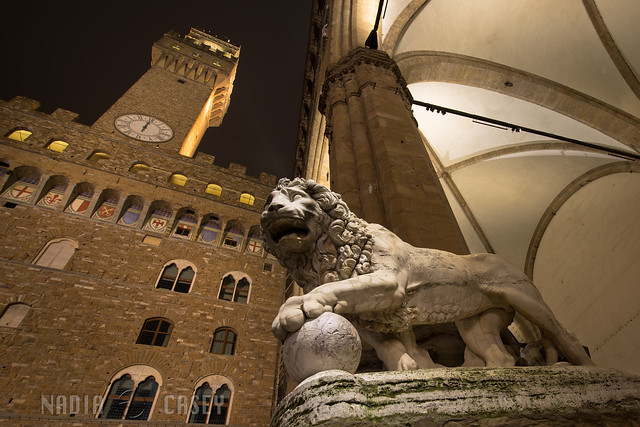
Lion of Florence
The Medici family did not start out as a wealthy or powerful family. Giovanni de' Medici was one of five sons of a poor widow and went to work for the family business, the Medici Bank. He became a shrewd businessman bolstering the family business through behind-the-scenes transactions that benefited his bank and ruined his competitive enemies, eventually becoming the "Capo" (head) of the Medici family... and he took the power of the Medici all the way to Rome. Giovanni supported his friend and ex-pirate, Baldassare Cossa's bid to become Pope. It was a risk, but in 1410 Cossa was elected Pope John XXIII, and Cossa handed over the entire Papal account to the Medici bank. Papal connections brought them immense power. Everyone wanted to bank where the church banked and the Medici ended up managing the wealth of Europe's highest ranking and richest families, including Royalty. As the Papal bank they collected 10% of your earnings for the Church, and if you couldn't pay, you faced excommunication.... and Giovanni de Medici became "God's Banker."
It was, however, Giovanni's son, Cosimo who further set up family alliances, creating and exploiting a vast social network of “amici degli amici" (friends of friends), sometimes through bribery, corruption and violence, that eventually won their powerful status through wealth, not by war or birthright. It was Cosimo who began turning their wealth into political capital... the descendants of Giovanni would become Popes, Cardinals, Archbishops, and Dukes, and it was Cosimo that made them the unofficial, yet undisputed, rulers of Florence."
Aeneas Sylvius, Bishop of Siena and later Pope Pius II, said of him, "Political questions are settled in [Cosimo's] house. The man he chooses holds office... He it is who decides peace and war... He is king in all but name."
(wiki)
Cosimo was noted for his patronage of culture and the arts, and encouraged his father to invest their wealth in civic patronage. He sustained his family's power by using art as their personal propaganda machine to promote their family image.
The Medici family would sponsor and protect the greatest artists, architects and thinkers of their time. (Masaccio, Brunelleschi, Donatello, Fra Angelico, Botticelli, Michelangelo, DaVinci, and more. The family was also the patron of the famous scientist Galileo.)
They were the "Godfathers of the Renaissance."

San Miniato al Monte
Basilica of Saint Minias on the Hill
A church that was built on the grave of the Christian Martyr Saint Minas. Around 250 A.D. when a Roman Emperor issued an edict for the suppression of Christianity, Minias was decapitated and buried on a hill across the river from the center of Florence. A church on the site was probably built not long after his death, but the current church was built starting in 1018. This is one of the more interesting churches in Florence that pre-date the Cathedral of Florence by about 300 years.

San Minato al Monte II
~ Duomo di Firenze (Cathedral of Florence) ~
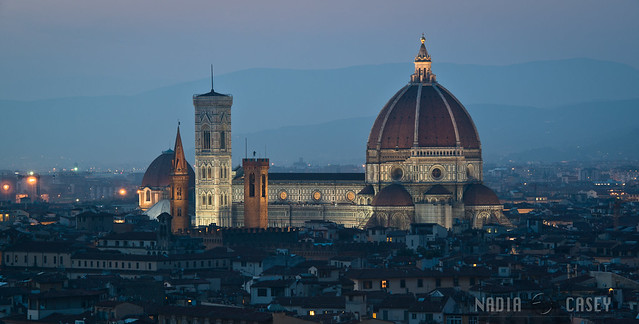
Il Duomo di Firenze
Il Duomo di Firenze is the main attraction in Florence and in our opinion could be one of the top five most interesting religious structures on earth.
The cathedral, Santa Maria del Fiore, whose construction was designed by Arnolfo di Cambio, is the third largest church in the world and was the largest in Europe at the time of its completion. It was built on the site of an earlier cathedral; an ancient building founded in the early 5th century, and having undergone many repairs, was crumbling with age, and was no longer large enough to serve the growing population of the city.
The new church was approved by city council in 1294, and the first stone was laid on September 9, 1296. The building of this vast project was to last 140 years, the collective efforts of several generations.
(wiki)

Brunelleschi's Sunset
Work on the cathedral was halted in 1348 due to the Black Death and resumed in 1349 under a series of architects until it was finished, with the exception of the facade and the dome, around 1367.
Sometime during the planning a decision was made to have an enormous cupola (dome) at the east end of the new cathedral. No one knew how Arnulfo di Cambio planned to build the cupola and its construction had never begun because building a self-supporting structure the size of the Duomo's cupola was considered impossible without using flying buttresses, which were not popular in Italy. Having the dome uncompleted was an embarrassment because "the cathedral was a symbol of the identity of the community, and without a dome you don't have a sacred building."
(PBS.org)
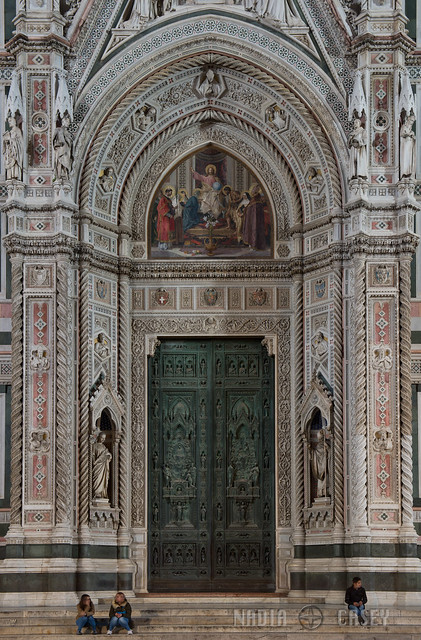
Duomo Door Front
Filippo Brunelleschi, was a goldsmith's apprentice, and one of the competitors for the bronze gates of the cathedral. But when his competitor Lorenzo Ghiberti won the commission, possibly because Brunelleschi refused to share the commission, Brunelleschi left for Rome in 1403 "in order to study ancient buildings, as he intended to pursue the study of architecture. He devoted himself to perspective, geometry, and study of antiquity, with such an intensity that, when he returned to Florence, no more accomplished master could be found."
Renaissance-Spell.com
And when Filippo Brunelleschi returned to Florence the Cathedral still needed a dome.
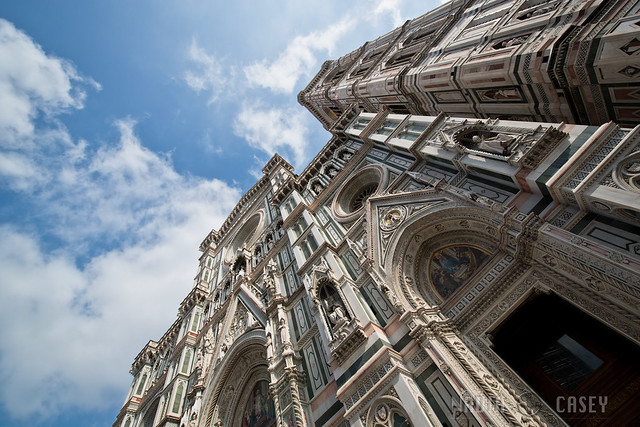
Under the Duomo Facade
In 1418 the Arte della Lana (the wool guild, patronized by wool manufacturers and merchants, rose to 3rd in precedence and took charge of Santa Maria del Fiore in 1282) announced a structural design competition in the search for a solution for erecting the dome. Giovanni and Cosimo de Medici wanted to lend their efforts to the problem and perhaps in the process bring power and glory to the Medici family.

Duomo Tower Side II
"In 1419, the Silk Merchants Guild - which included the Medici - commissioned the construction of a state orphanage. Brunelleschi worked hard to win the tender. He had already worked for the Medici, redesigning their parish church, San Lorenzo, along classical lines. Now, with these new buildings, a revolution began. Soon enormous Roman capitals and pillars, monumental windows and carved stones appeared, making this the first time true pillars were used for structural support since Ancient Roman times."
(PBS.org)
Despite his other accomplishments, Brunelleschi wanted the greatest prize of all, the Cathedral dome. His plan was eventually accepted and though Brunelleschi had no formal training, if he was to succeed in building the dome he would have to re-write the rules of Western architecture.
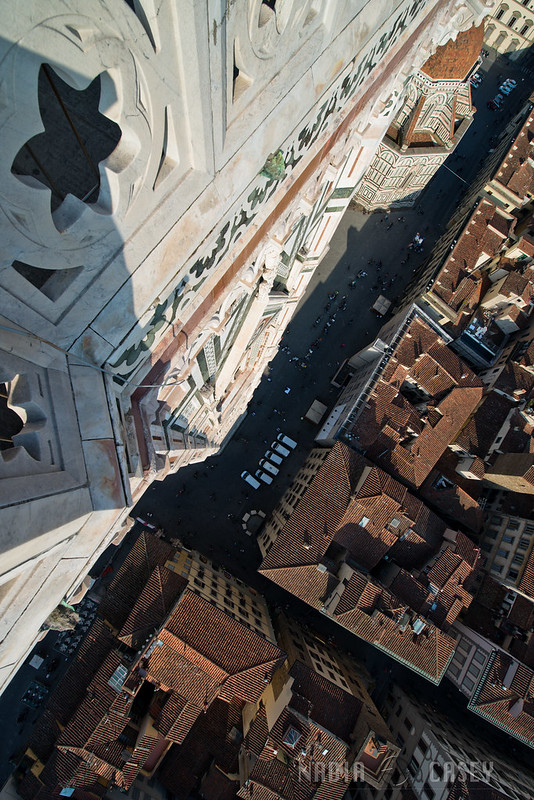
Duomo Tower Side
With the backing of the Medici, Brunelleschi had the opportunity to bring new ideas to the building site. "Every day, he ensured workers remained sober by providing their lunch and watering down the wine. A safety net prevented workers from falling to their deaths, a chiming clock regulated their working hours and Brunelleschi had a canteen half way up the dome. His methods seemed to work. Only three deaths were recorded during a 16-year construction period." (1420-1436)
(PBS.org)
Also, it was Brunelleschi, (and perhaps could be argued his greatest achievement) who in 1434 invented linear perspective.
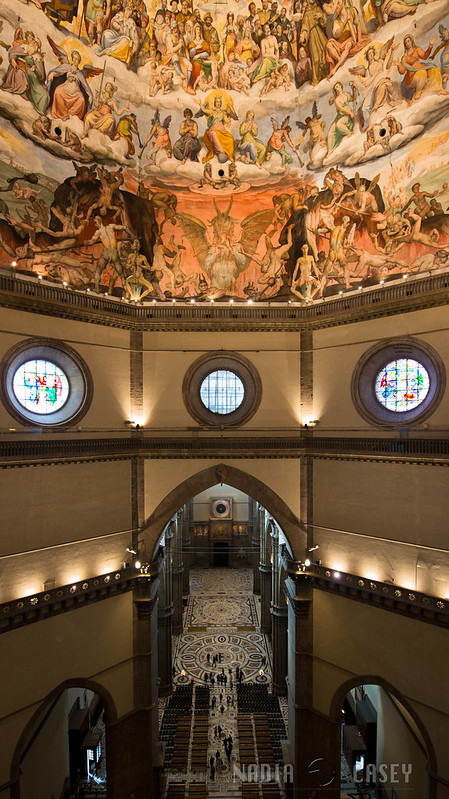
Inside the Dome
"With the dome complete, Cosimo de'Medici invited the Pope himself to consecrate the finished Cathedral on Easter Sunday, 1436. The dome towered majestically over the city of Florence, a triumph for the Florentine people and the city's most powerful family.
Weighing 37,000 tons and using more than 4,000,000 bricks, Brunelleschi's dome was the greatest architectural feat in the Western world."
(PBS.org)

Looking Up At Brunelleschi
Brunelleschi died in 1446 and was buried beneath his towering achievement, where he remains to this day. He was the first engineer of the Renaisssance.
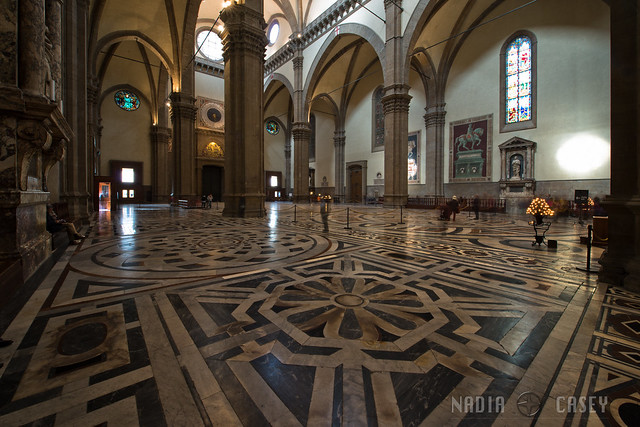
Duomo Floor
The church is particularly notable for its 44 stained glass windows, the largest undertaking of this kind in Italy in the 14th and 15th century. The windows in the aisles and in the transept depict saints from the Old and the New Testament, while the circular windows in the drum of the dome or above the entrance depict Christ and Mary. They are the work of the greatest Florentine artists of their times, such as Donatello, Lorenzo Ghiberti, Paolo Uccello and Andrea del Castagno.

Looking Down The Dome

Florence Baptistery
The Baptistery is one of the oldest buildings in Florence. It is a religious building also known as the Baptistry of Saint John and has the status of a minor basilica. Its construction started between 1059 and 1128 in the Florentine Romanesque style. Its influence formed the basis from which Brunelleschi and other architects created Renaissance architecture.
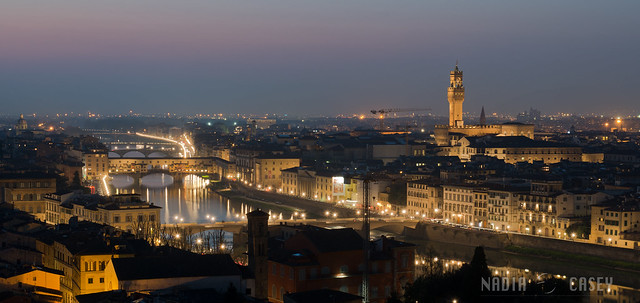
Arno Lights
The renaissance marked a great cultural change. It was a period that exploded with free thinking that spread to artists and architects throughout Europe. Cities became politically and economically successful with institutions such as banking, workshops and universities that produced ideal conditions for the emergence of Humanism, and gave rise to many innovations in art, architecture, medicine, science, and literature, among others. Beginning with the Italian Renaissance new thinking eventually spread to the rest of Europe and changed the world.
Italian-Renaissance-art.com

View this album on flickr

Florence Skyline
Florence is ranked by Forbes as one of the most beautiful cities in the world. We think it is the ultimate attraction for city-lovers whose interests lay in urban-life-culture with a renaissance feel.

Viewing Florence from the top of Brunelleschi's Dome.
Florence was politically, economically, and culturally one of the most important cities in the world during the 14th to 16th centuries. It originated as a Roman city, then later flourished as a medieval city of European trade and finance, and was one of the wealthiest cities of the time. It is still noted for its culture, art, architecture, monuments, art galleries and some of the best museums in the world.

Uffizi Gallery
One of the greatest art galleries in the world is The Uffizi gallery. The original reason for its construction is interesting. Granduca Francisco de' Medici was in constant fear of attempts on his life, so in 1581, he had enclosed walkways and buildings built so he wouldn't have to walk outside amongst those who could take aim at him.
"The original design was that of Giorgio Vasari, one of the leading painters and architects during the 15th century. His plan for this museum was quite a strategically planned building as it was constructed adjacent to the Medici Palace and extended until the Arno river, over the Ponte Vecchio bridge. The space was originally intended for offices and to host bureaucratic meetings for various magistrates."
http://www.uffizi.com/

Ponte Vecchio (Old Bridge)
A medieval stone bridge over the Arno River, in Florence, Italy, noted for shops built along it, as was once common. Butchers initially occupied the shops; the present tenants are jewelers, art dealers and souvenir sellers.

Palazzo Vecchio
The fourteenth and fifteenth centuries in Italy are frequently called, "the Golden Age", one of the most brilliant periods in world art history, and at its heart is Florence with its writers, painters, architects, and philosophers. It is considered the birthplace of the Renaissance. There are many famous men we think of when we think of the Renaissance, like DaVinci, Michelangelo, and Botticelli, however it was the The House of Medici, a rich, powerful, and influential banking family with a passion for culture, that gave us the Renaissance. The late 14th century was a time of rebirth in the appreciation of the classical past "that changed the face of western culture and left no doubt that the Medici were the patrons, the catalyst of genius."
PBS.org Medici/Renaissance
education-portal.com

Lion of Florence
The Medici family did not start out as a wealthy or powerful family. Giovanni de' Medici was one of five sons of a poor widow and went to work for the family business, the Medici Bank. He became a shrewd businessman bolstering the family business through behind-the-scenes transactions that benefited his bank and ruined his competitive enemies, eventually becoming the "Capo" (head) of the Medici family... and he took the power of the Medici all the way to Rome. Giovanni supported his friend and ex-pirate, Baldassare Cossa's bid to become Pope. It was a risk, but in 1410 Cossa was elected Pope John XXIII, and Cossa handed over the entire Papal account to the Medici bank. Papal connections brought them immense power. Everyone wanted to bank where the church banked and the Medici ended up managing the wealth of Europe's highest ranking and richest families, including Royalty. As the Papal bank they collected 10% of your earnings for the Church, and if you couldn't pay, you faced excommunication.... and Giovanni de Medici became "God's Banker."
It was, however, Giovanni's son, Cosimo who further set up family alliances, creating and exploiting a vast social network of “amici degli amici" (friends of friends), sometimes through bribery, corruption and violence, that eventually won their powerful status through wealth, not by war or birthright. It was Cosimo who began turning their wealth into political capital... the descendants of Giovanni would become Popes, Cardinals, Archbishops, and Dukes, and it was Cosimo that made them the unofficial, yet undisputed, rulers of Florence."
Aeneas Sylvius, Bishop of Siena and later Pope Pius II, said of him, "Political questions are settled in [Cosimo's] house. The man he chooses holds office... He it is who decides peace and war... He is king in all but name."
(wiki)
Cosimo was noted for his patronage of culture and the arts, and encouraged his father to invest their wealth in civic patronage. He sustained his family's power by using art as their personal propaganda machine to promote their family image.
The Medici family would sponsor and protect the greatest artists, architects and thinkers of their time. (Masaccio, Brunelleschi, Donatello, Fra Angelico, Botticelli, Michelangelo, DaVinci, and more. The family was also the patron of the famous scientist Galileo.)
They were the "Godfathers of the Renaissance."

San Miniato al Monte
Basilica of Saint Minias on the Hill
A church that was built on the grave of the Christian Martyr Saint Minas. Around 250 A.D. when a Roman Emperor issued an edict for the suppression of Christianity, Minias was decapitated and buried on a hill across the river from the center of Florence. A church on the site was probably built not long after his death, but the current church was built starting in 1018. This is one of the more interesting churches in Florence that pre-date the Cathedral of Florence by about 300 years.

San Minato al Monte II
~ Duomo di Firenze (Cathedral of Florence) ~

Il Duomo di Firenze
Il Duomo di Firenze is the main attraction in Florence and in our opinion could be one of the top five most interesting religious structures on earth.
The cathedral, Santa Maria del Fiore, whose construction was designed by Arnolfo di Cambio, is the third largest church in the world and was the largest in Europe at the time of its completion. It was built on the site of an earlier cathedral; an ancient building founded in the early 5th century, and having undergone many repairs, was crumbling with age, and was no longer large enough to serve the growing population of the city.
The new church was approved by city council in 1294, and the first stone was laid on September 9, 1296. The building of this vast project was to last 140 years, the collective efforts of several generations.
(wiki)

Brunelleschi's Sunset
Work on the cathedral was halted in 1348 due to the Black Death and resumed in 1349 under a series of architects until it was finished, with the exception of the facade and the dome, around 1367.
Sometime during the planning a decision was made to have an enormous cupola (dome) at the east end of the new cathedral. No one knew how Arnulfo di Cambio planned to build the cupola and its construction had never begun because building a self-supporting structure the size of the Duomo's cupola was considered impossible without using flying buttresses, which were not popular in Italy. Having the dome uncompleted was an embarrassment because "the cathedral was a symbol of the identity of the community, and without a dome you don't have a sacred building."
(PBS.org)

Duomo Door Front
Filippo Brunelleschi, was a goldsmith's apprentice, and one of the competitors for the bronze gates of the cathedral. But when his competitor Lorenzo Ghiberti won the commission, possibly because Brunelleschi refused to share the commission, Brunelleschi left for Rome in 1403 "in order to study ancient buildings, as he intended to pursue the study of architecture. He devoted himself to perspective, geometry, and study of antiquity, with such an intensity that, when he returned to Florence, no more accomplished master could be found."
Renaissance-Spell.com
And when Filippo Brunelleschi returned to Florence the Cathedral still needed a dome.

Under the Duomo Facade
In 1418 the Arte della Lana (the wool guild, patronized by wool manufacturers and merchants, rose to 3rd in precedence and took charge of Santa Maria del Fiore in 1282) announced a structural design competition in the search for a solution for erecting the dome. Giovanni and Cosimo de Medici wanted to lend their efforts to the problem and perhaps in the process bring power and glory to the Medici family.

Duomo Tower Side II
"In 1419, the Silk Merchants Guild - which included the Medici - commissioned the construction of a state orphanage. Brunelleschi worked hard to win the tender. He had already worked for the Medici, redesigning their parish church, San Lorenzo, along classical lines. Now, with these new buildings, a revolution began. Soon enormous Roman capitals and pillars, monumental windows and carved stones appeared, making this the first time true pillars were used for structural support since Ancient Roman times."
(PBS.org)
Despite his other accomplishments, Brunelleschi wanted the greatest prize of all, the Cathedral dome. His plan was eventually accepted and though Brunelleschi had no formal training, if he was to succeed in building the dome he would have to re-write the rules of Western architecture.

Duomo Tower Side
With the backing of the Medici, Brunelleschi had the opportunity to bring new ideas to the building site. "Every day, he ensured workers remained sober by providing their lunch and watering down the wine. A safety net prevented workers from falling to their deaths, a chiming clock regulated their working hours and Brunelleschi had a canteen half way up the dome. His methods seemed to work. Only three deaths were recorded during a 16-year construction period." (1420-1436)
(PBS.org)
Also, it was Brunelleschi, (and perhaps could be argued his greatest achievement) who in 1434 invented linear perspective.

Inside the Dome
"With the dome complete, Cosimo de'Medici invited the Pope himself to consecrate the finished Cathedral on Easter Sunday, 1436. The dome towered majestically over the city of Florence, a triumph for the Florentine people and the city's most powerful family.
Weighing 37,000 tons and using more than 4,000,000 bricks, Brunelleschi's dome was the greatest architectural feat in the Western world."
(PBS.org)

Looking Up At Brunelleschi
Brunelleschi died in 1446 and was buried beneath his towering achievement, where he remains to this day. He was the first engineer of the Renaisssance.

Duomo Floor
The church is particularly notable for its 44 stained glass windows, the largest undertaking of this kind in Italy in the 14th and 15th century. The windows in the aisles and in the transept depict saints from the Old and the New Testament, while the circular windows in the drum of the dome or above the entrance depict Christ and Mary. They are the work of the greatest Florentine artists of their times, such as Donatello, Lorenzo Ghiberti, Paolo Uccello and Andrea del Castagno.

Looking Down The Dome

Florence Baptistery
The Baptistery is one of the oldest buildings in Florence. It is a religious building also known as the Baptistry of Saint John and has the status of a minor basilica. Its construction started between 1059 and 1128 in the Florentine Romanesque style. Its influence formed the basis from which Brunelleschi and other architects created Renaissance architecture.

Arno Lights
The renaissance marked a great cultural change. It was a period that exploded with free thinking that spread to artists and architects throughout Europe. Cities became politically and economically successful with institutions such as banking, workshops and universities that produced ideal conditions for the emergence of Humanism, and gave rise to many innovations in art, architecture, medicine, science, and literature, among others. Beginning with the Italian Renaissance new thinking eventually spread to the rest of Europe and changed the world.
Italian-Renaissance-art.com

View this album on flickr
I really loved this whole post! I can't wait to visit some of these places. Thanks for sharing.
ReplyDelete